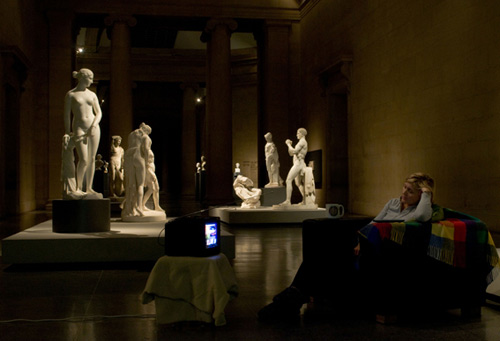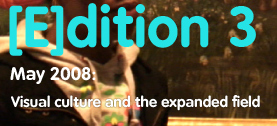Image/Sound/Text:
Art imitates life or life imitates art?
On one of my first visits to Tate Britain I noticed a chair. If my memory serves me correctly, this chair was Victorian and this posed a question for me: surely this chair belongs in a general museum, not in an art museum? By this chair simply being in the gallery, doesn’t it automatically raise this chair to the status of art? From this initial encounter I went on to consider whether it would be possible within the Tate Encounters project to bring a living room, something synonymous with television, into the gallery, which is synonymous with art. This posed the question for me that if I took the living room into Tate Britain, would it then become art? The purpose of the exercise was to produce a photographic document of the living room and the gallery.
I also became interested in the process of accessing the gallery, seeing how open the gallery would be and what I would have to negotiate to take the table and television into the Duveen Galleries and make the photograph. In addition to the actual shoot, I arranged with Tate Encounters researchers to videotape the session so as to give an insight into the complexities of co-coordinating such a shoot.
Action List – Robbie’s photo shoot 23.04.08
- Sarah and Morten to meet Robbie and friend ESTHER GRAY AT 08.30 TB staff entrance.
- Collect 2 named security passes from staff entrance for ROBBIE SWEENY and ESTHER GRAY.
- Collect trolley, extension lead and duct tape from staff entrance.
- Morten: Transport TV from Tate Encounters Office, extension lead and tape to South Duveens.(TV electric checked 22/04/08 job ref:
- Sarah: Collect mini DV tapes from TE office. Transport filming kit to South Duveens.
- Porters to move chair from reading area to right of South Duveen entrance to left corner of South Duveen (job ref: ). To be returned by 09.45 by porters.
- Morten: Tape down any loose cables from TV.
Restrictions:
NO LIGHTING. NO CLOSE-UP IMAGES OF SCULPTURES TO BE TAKEN
Reflections on the shoot in answer to email questions asked by Andrew Dewdney
Q. What did you think would be involved in taking the picture?
A. Initially, I had imagined that the shoot would be relatively straight-forward as the only real prop I was bringing into the Tate environment was a small television. I imagined that I would come along some morning or evening when the Tate was closed to the public, set-up the shoot in about ten minutes, photograph the scenario in about an hour, and then pack up and leave.
Q. What response to your idea were you met by and how did you feel about that?
A. The initial response was quite positive and encouraging, but then it became clearer that there was going to be a lot of red tape involved. As this project needed to be completed within a certain period of time, it was touch and go as to whether or not the shoot would go ahead. It was frustrating at times, as for a short period I was not able to receive a ‘yes’ or a ‘no’ as to whether or not I should continue with my efforts. I found it confusing as to why there were so many issues as I had photographed at the Tate prior to this and the issues such as insurance and copyright had not been a problem then, but at the same time I did understand that a place such as the Tate does need to take certain precautions.
Q. During the shoot what was you experience of the event?
A. The shoot itself went very smoothly. There was an initial hold up due to a trolley being ordered, but it had never been taken care of, but this was not a problem as there was not a lot to transport through to the location of the shoot. Once we were there it was quite surreal to have the Tate to ourselves. It was as I had hoped. I set up the props and my tripod and experimented with various angles. It was all very straight-forward and completed within the hour.
Q. How have you subsequently reflected upon that experience?
A. Looking back on the project, on the whole it was a very positive, unique experience. There were things I would have done differently, namely the timing, I would have tried to give myself and the Tate more time in which to organise the shoot. I also would have tried to have given myself the option of having two shoots, one being the dummy shoot in which I might have identified any issues such as lighting or angles, and then I would have addressed these in the follow-up shoot. I was lucky enough to have had the help of Dr. Isabel Shaw and Sarah Thomas, without their help in liaising with the various departments of the Tate, I don’t think the shoot would have gone ahead.
Q. What is your view now of the pictures taken on that shoot?
A. On the whole I am very proud of these pictures. I was aiming to capture a dark, atmospheric, yet mildly mundane feeling, with which to contrast the regal feeling of the gallery's hallway, and I think I managed to capture this. There are, however, a few technical issues I would have addressed had I the option to do the shoot again. I think some areas of the photo could be lit better, namely the subject’s legs and some of the background areas. Also, I was hoping to get a specific lighting effect from the television, which I was unable to do, so given more time I would have researched how I could have gone about obtaining this effect.
Q. What did you learn about Tate from the overall experience?
A. I have learned that Tate is not unlike any other large institution, there is a lot of bureaucracy involved in the planning of an event, no matter how small. It has given me a better understanding of the intricacies that a gallery has to deal with on its many levels.
I had never imagined prior to this experience that in order for a piece of art to be moved, that an art handler would have to be employed in order for the piece to be moved. Nor would I have contemplated that permission needed to be given in order to be able to use the electrical sockets. Like any place where public events occur, we do not really think about what goes on behind the scenes or what happens in the space when we are not there, but in working on the Tate Encounters project, specifically this shoot, I have been given a glimpse into how this world operates. It can be a frustrating and difficult environment when things do not go your way, but when things work out, the rewards make these obstacles worth the perseverance.

© Robbie Sweeny






